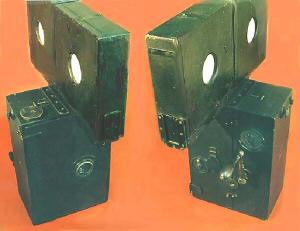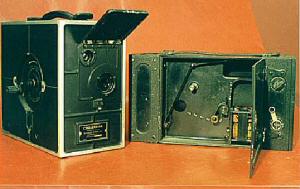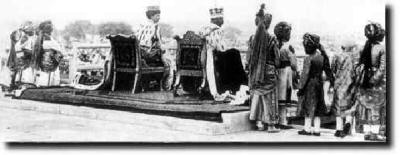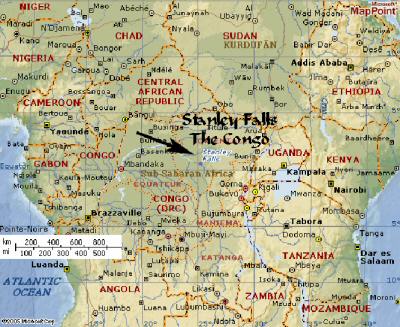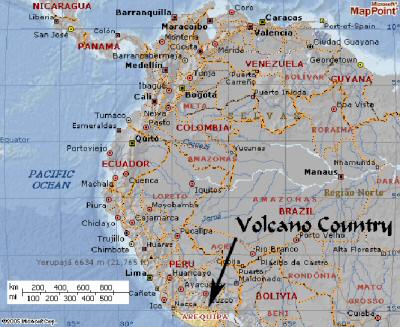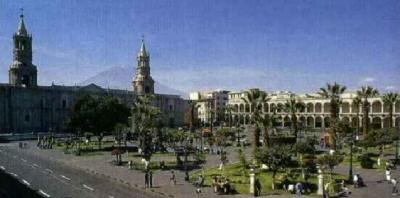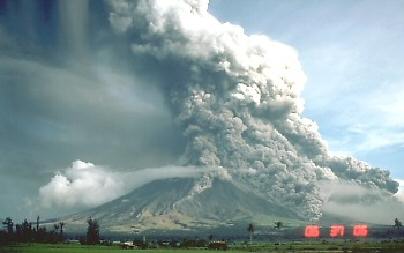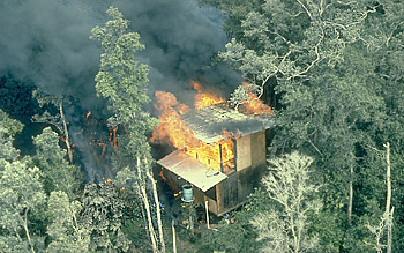Tom Swift and His Wizard Camera
or, Thrilling Adventures While Taking Moving Pictures
By Victor Appleton Book #14 ę1912
~ Alternate Titles ~
Tom Swift and His Electric Camera1
or, The Perils of Moving Picture Taking2
Review by JP Karenko, June 2005
Full-color image courtesy of Carl Swanstrom
Image of a White Quad and Duotone dustjacket is courtesy of Mark Snyder
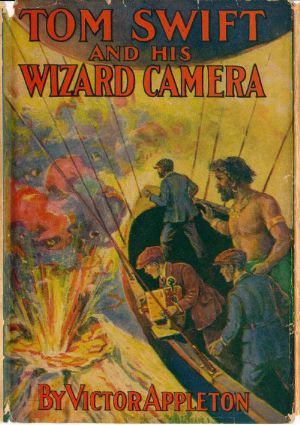 Note:
some of the language, references & attitudes, while acceptable at the time
they were written, are not Politically Correct, today.
Note:
some of the language, references & attitudes, while acceptable at the time
they were written, are not Politically Correct, today.
Summary: No official summary was ever provided with any of the old Tom Swift books. However, without giving too much away, the plot can be summed up as follows:
The story opens with Tom bored out of his mind. It's been 6 months since his Escape From Captivity, and working on his noiseless airship motor pales in comparison. He is introduced to a "moving picture promoter," one James "Spotty" (Wait!-I know what you are thinking-says he) Period. This portly gentleman, who has the annoying verbal habit of interrupting even himself engages Tom to build a revolutionary electric powered motion picture camera. Tom is then tasked with cruising the world, playing Paparazzi. Mr. Period is in need of spectacular newsreel films to show in theaters, both as filler and for travelogues. Mr. Amos Nestor, Mary's father, is a prime stockholder in Period's company, and Tom takes on the challenge, not just for the money, but as a chance to bond with the man who may become his future father-in-law.
The camera is designed in a week, built in 3 more and "perfected" shortly thereafter. (Sigh, such efficiency!) Tom also builds from scratch, a new super-sized airship, the Flyer, along the same impractical lines as his previous biplane/dirigible creations, Red Cloud, Black Hawk and Falcon. This one has all the usual luxuries, plus a pressurized cabin, transcontinental range, a machine shop (including a forge)-and a darkroom. Considering Falcon already had transcontinental capability, this one must be a monster in size.
Danger-animal, mineral, vegetable and meteorological-lies everywhere. Tom gets it all on film.
You can probably guess the outcome, but you'll have to read the story (or go to a theater) to be sure.
This book is available, online. Tom Swift and His Wizard Camera
1 p218 Closing text Tom Swift in Captivity
2 p219 Advertising flyleaf Tom Swift in Captivity
![]()
Cast of Characters (More or less in order of appearance)
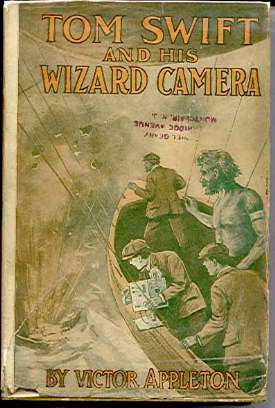 Koku
or August ˝ Eight foot
plus native giant purloined from the South American jungles in Book #13. Now
in the employ of Tom Swift as a bodyguard, manservant, and devoted companion.
He has learned English well, except for a propensity to sound a bit like Yoda
from Star Wars. Much is made of his name change to August. Except for
the initial to-do, he is always referred to as "Koku," his original name.
Competently pilots the Flyer, and is given his very own Electric
Rifle, after saving Tom's life.
Koku
or August ˝ Eight foot
plus native giant purloined from the South American jungles in Book #13. Now
in the employ of Tom Swift as a bodyguard, manservant, and devoted companion.
He has learned English well, except for a propensity to sound a bit like Yoda
from Star Wars. Much is made of his name change to August. Except for
the initial to-do, he is always referred to as "Koku," his original name.
Competently pilots the Flyer, and is given his very own Electric
Rifle, after saving Tom's life.
Tom Swift ˝ Intrepid inventor & mechanic. Plucky, lively, resourceful, brave and clever. Home˝schooled at a college level by his father, Barton Swift. Athlete and hunter. Familiar with how to stalk game and firearms. Loves all things mechanical. Is a decent cook, too. In this episode, he shows a reckless streak that is near suicidal. When he gets a camera in his hands, his brain shuts down and common sense flies away..
James ("Spotty" or "Jim") Period -- Short, stout, fussy individual with a spit-on-the-griddle energy that drives everyone around him to distraction. Repeats himself endlessly, even to interrupting himself in the middle of his own sentences. Preoccupied with how much money he is losing by taking the time converse. Would do well to say things once and move on, or use a telephone instead of traveling so much.'
Ned Newton - So far, has never been described. Chum & companion of Tom, Apparently no longer employed at Shopton National Bank.(Probably fired for spending so much time gallivanting around the world.) He is now a regular fixture in Tom's adventures.
Mrs. Baggert ˝ Housekeeper & mother figure. Kindly, and "loves Tom like a son." Employed by the Swift family since the time Tom's mother died. She is short of stature and has to stand on a soap box to kiss Tom goodbye on one of his voyages. Excitable, she seems to expect fatalities after any mishap involving Tom's inventions.
Mr. Wakefield Damon ˝ Elderly & eccentric adventurer whose main purpose in life seems to be blessing everybody and everything near his person. Apparently no longer overweight and sickly, as originally described. Has not crashed any vehicles, lately, either-He has had issues with keeping mechanical contrivances and even horses, under control.
Barton Swift ˝ Widower. Wealthy and conservative. Inventor, master machinist and holder of numerous patents. In this episode, described as having aged greatly, probably due to Tom's extended absence while captive.. Still at work on a new gyroscope device.
Eradicate Sampson, A.K.A. Eradicate or Rad ˝ Rad's middle names, (Andrew Jackson Abraham Lincoln,) are no longer used. Aged stereotypical Negro journeyman jack˝of˝all˝trades. "Eradicates dirt." Now is in full-time residence on the Swift estate, and maintains his own chicken coop. Heavy deep˝south accent and Uncle Remus attitude. Caretaker of Boomerang, a cantankerous, aged and now ailing, mule.
Rad is now described as feeble, aged and tottering, too old to go on adventures with Tom any longer. This causes him much distress, as rival Koku drops into the empty spot in Tom's crew.
Male Prowler-No name or description. Appears to have set a deadfall trap for Tom, in his workshop.
Unnamed Town Doctor-Ministers to Tom after he is overcome by noxious gas in his shop.
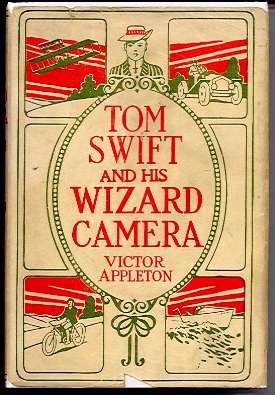 Wilson
Turbot-No description
given. Rival of James Period. Tries to hire away Tom, and buy his camera.
Sabotages Tom's efforts when refused.
Wilson
Turbot-No description
given. Rival of James Period. Tries to hire away Tom, and buy his camera.
Sabotages Tom's efforts when refused.
William Eckert-No description given. 2nd Rival of James Period. In league with Turbot, above.
Samuel Rastus Washington Jackson Johnson-No description given, except as 2nd cousin to Rad. Caught on film "counting Rad's chickens" after dark, during a test of the Wizard Camera. Chased off the property.
Mr. (Amos) Nestor-No description, other than as Mary's father. First name never mentioned in this story, even though he is a principal character. Mrs. Nestor doesn't even rate a mention.
Miss Mary Nestor-Love interest of Our Hero. Passing mention only in this tome.
Crew & Officers of SS Belchar-Passing mention only. No descriptions given.
Famous Paranoid Millionaire-Passenger on SS Belchar. No description given. Wants to hire away Koku as a bodyguard.
Calcutta Agent of Mr. Period- No description given. Passing mention.
Mr. & Mrs. Janeway- No descriptions or first names given. Christian missionary friends of Illingways. Run a Congo mission station, near Stanley Falls.
Bruce Montgomery-British agent of Turbot & Eckert. Burgles Tom's camera, late in story.
Wade Kenneth-British agent of Turbot & Eckert. In league with Montgomery, above.
US Consul, Lima Peru-No name or description. Passing mention.
![]()
Major Inventions
Tom Swift starts this tale working on parts to his "noiseless airship," (the Falcon with a modified power-plant) which will be utilized in the next volume. He also invents the Wizard Electric Powered Moving Picture Camera. It is revolutionary, in that it is small, lightweight and does not have to be cranked by hand. Current technology cameras of that day were muscle powered. The WC has an on-board electric light so that pictures may be taken after dark, and can be set to run either on a timer or by a hard-wired remote control. Power is provided either by a storage battery or external power provided by a dynamo. It is a small square box with the lens (and presumably the light) on the front. Another feature is the ability to change films in daylight without using the usual "dark bag" and a window that allows the operator to see how much film remains for use. (My father's 1950 Kodak 8mm movie camera had to have film changed in shade or near-darkness and still showed streaks from light leakage if the film was not handled carefully.) Originally mounted vertically in the floor of Tom's airship, a series of reflectors is built as an accessory that allows the camera to be pointed horizontally while in flight "for better views." In spite of the small size, film reels lasted a long time. 40 years later, my Dad's 8mm had a run time of about 7 minutes. The film was actually 16mm wide and was only exposed down half its' width. At the end of the roll, the film was removed, flipped over and the other half exposed. Much editing and splicing ensued to make home-movie watching practical. Tom's magic box did not have such limitations.
The Flyer was also custom built just for the trip. It is now pressurized for high altitude travel, and has a darkroom on board as well as the usual De Luxe accommodations. Anyone who has read any of the previous stories knows about these behemoth floating Rube Goldberg airships. Parking space at the Swift's house must be getting tight. Tom now has at least 4 dirigible/biplanes, plus the Scooter, Lark, Butterfly and Vulture Air Glider.
![]()
Commentary on Society, Attitudes, Environment & Errata
It's amazing how much technology has changed in 95 years. Reading the old Tom Swift Sr. series has really given me an appreciation of all the modern gadgets that I've come to take for granted. Modern transportation, Hollywood motion pictures, movie SFX and my little Sony digital Handycam are a few. I wonder what people will be taking for granted 100 years from now, and what they will think of our times, mores and attitudes?
Attitudes, Prejudices and Circumstances ˝ When Tom gets a camera in his hands, concern and common sense fly out the window. To get "interesting scenes" of elephants, he flies the monster airship over a herd of pachyderms. This of course spooks them, prompting a stampede. Folks on the ground, now in danger of life and limb, are righteously upset. Tom just shrugs it off as the cost of doing business. Later, we see him on the slopes of an erupting volcano, shooting away while the ground opens at his feet. Sigh, the immortality of youth' The usual prejudices abound, with Englishmen being referred to as "strange," and native peoples being called "black beggars." Koku, on the other hand has moved up the food chain, a bit. He rescues Tom several times, and when it is determined that he is a crack shot with a rifle, Tom gives him his very own Electric Rifle to keep, in gratitude. It is the only one ever to be given away, even to Ned or Mr. Damon (neither of which handles a gun very well, in my opinion.)
On p36 Tom & Ned chase a burglar "pantingly." This is the first usage of what will eventually become the short-lived craze of the late 60's, "Tom Swifties." On p88 the sailors on a commercial steamship sound like a bunch of Hollywood pirates peppering their conversation with "shiver me timbers," et cetera.
Errata˝ Mr. Damon is left in Waterfield, NY, for this volume. The current score of his many moves between there and Waterford stands at 9-Waterfield, 2-not recorded, and 5-Waterford for 14 volumes, to date. The numbers don't total, because two volumes have him residing in both places at the same time.
Typos were few and far between. On p45, a chat (chap) is referred to, on p76, they develope films, on p78 happening only has one 'p', and on p189 the foamy rock coming from the volcano as two 'm's, pummice.
Tom is said to film tigers in the Congo Free Republic. Lately, some of the cats have been relocated to Africa to try and save them from extinction, (mainly further south) but in those days, it just proved that office dwellers should do better research, especially for boy's adventure books.
Engineering and Science, Fact vs. Fantasy ˝ I spend a lot of time piddling on the design of Tom's airships. The Flyer is no exception. It is a super-sized version of previous dirigible/biplane hybrids, and in addition to the usual leaky gas bag filled with explosive lifting gas, it now sports a pressurized oxygen-enriched cabin. The author(s) must have been called to task about anoxia while flying over places like the Himalayas and Alps' In any case, this monster gets down and dirty around an erupting volcano, and in a real world, Tom would be a Crispy Critter or a Sizzling Swift Sausage. Another feature of this new machine is its' notorious unreliability. It breaks down several times in the most inconvenient times and places, making the occupants scramble to keep from being burned, buried or eaten.
Tom works on a "new sort of electricity" early in the story. I'll assume the authors meant "electric storage cell," as acid is being used during this part of the tale. Tom is not said to have any protective gear-gloves, goggles or even an apron-and gets an acid burn on his hand. My old Chemistry instructor would have had him in detention and banned from the lab for such careless behavior. As it is, he ends up overcome by fumes, but makes the usual miraculous recovery with no lasting ill effects. In today's world, the publisher would probably get sued for promoting unsafe experimental practices by inventor-wannabe readers.
Camera Tech -- When the movie 2001 A Space Odyssey came out in 1968, (almost 40 years ago!) I was 2 years into engineering college and was totally enthralled with the advanced hardware being casually shown "in everyday use." The tablet computers ( my Palm Pilot is smaller-Nyah nyah') and the micro-sized video cams were most impressive to me. These were the days when a "portable" (video) camera was a shoebox sized monster and the associated recorder was "bigger than a breadbox," and a lot heavier. The camera shown in the film (see below) was near magic. My 2001 Sony Digital Handycam is the realization of that "science fiction." It is a bit more bulky than the device shown in the movie, (see clip, below) but my camera's tech is already 3 years old and newer machines (not to mention video capture cell phones!) are much smaller. Tom Swift would have drooled at the chance to take one of these on his expeditions..
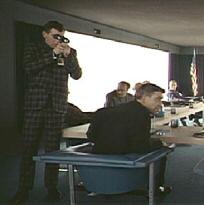
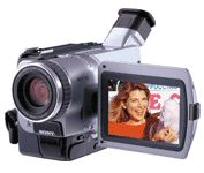
2001 Cam (SFX) 2001 Cam (Reality)
Antique camera images below are courtesy of http://www.xs4all.nl/~wichm/cinimage.html
